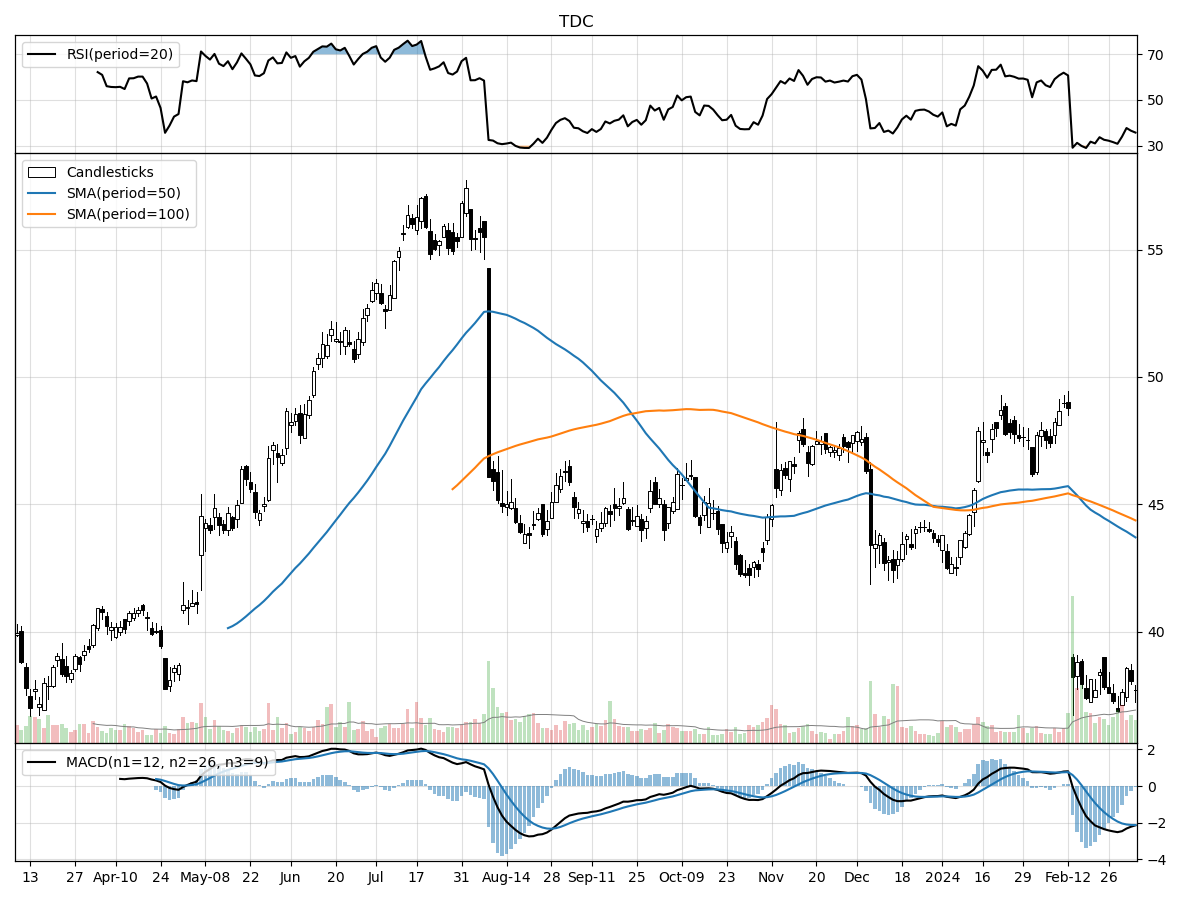Teradata (TDC), Mid/Small Cap AI Pick of the Week
March 7, 2024
Weekly AI Pick from the S&P 400 or S&P 600
Company Overview
Teradata Corporation is a company that specializes in providing cloud analytics and data platform services, leveraging artificial intelligence (AI) to help organizations tackle data and analytics challenges. Their flagship product, Teradata Vantage, is designed for enterprise data integration and analytics across various environments, from cloud to on-premises. In 2023, Teradata enhanced its offerings by launching VantageCloud Lake on AWS and Azure, acquiring Stemma Technologies to boost AI analytics, and developing ask.ai for natural language data querying. The company has also strengthened its AI/ML capabilities through partnerships with major tech firms like Microsoft Azure, Google Vertex AI, Dataiku, and Dell Technologies.
Teradata has been operational since 1979, with a public offering in 2007, and focuses on serving large-scale data users. The company's revenue for 2023 was $1.833 billion, primarily from the Americas, with a subscription-based pricing model that has become increasingly prevalent. Teradata's business strategy emphasizes cloud migration, operational excellence, and expanding its customer base across various industries. The company experiences seasonal variations in contract bookings, with the fourth quarter being particularly strong.
Sales and marketing of Teradata's solutions and services are conducted through a direct sales force, emphasizing hybrid multi-cloud technology, AI, and analytics. The company's revenue is mainly recurring, supported by customer services that include consulting and managed services. To enhance its market position, Teradata engages in strategic partnerships with various cloud service providers, software vendors, system integrators, and consultants.
Research and Development are crucial to Teradata, which holds numerous U.S. patents and actively protects its intellectual property rights. The company relies on Flex Ltd. for hardware assembly, maintaining quality and supply chain continuity through preferred supplier relationships. As of December 31, 2023, Teradata employs about 6,500 people worldwide, having reduced its headcount that year as part of a cloud-first and profitable growth strategy. The company promotes a diverse and inclusive culture, competitive compensation, and focuses on employee development and engagement.
The executive team at Teradata includes industry veterans such as President and CEO Stephen McMillan, CFO Claire Bramley, Chief Revenue Officer Todd Cione, Chief People Officer Kathleen Cullen-Cote, Chief Customer Officer Michael Hutchinson, and Chief Marketing Officer Jacqueline Woods. Teradata is committed to transparency, making its financial reports and governance documents accessible on its website and through the SEC.
By the Numbers
Total revenue (Annual): $1,833 million, a 2% increase from the previous year.
- Recurring revenue growth (Annual): 5% increase.
- Perpetual software license, hardware, and other revenue (Annual): 31% decrease.
- Consulting services revenue (Annual): 5% decrease.
- Gross profit margin (Annual): Improved to 60.8% from 60.2%.
- Operating income (Annual): Rose to $186 million from $118 million.
- Net income (Annual): Increased to $62 million from $33 million.
- Total Annual Recurring Revenue (ARR) (Annual): Grew by 6% to $1,570 million.
- Public Cloud ARR (Annual): Jumped by 48% to $528 million.
- Maintenance and Software upgrade rights ARR (Annual): Declined by 38%.
- Revenue growth in the Americas (Annual): 5% increase.
- Gross profit margin in EMEA (Annual): Improved due to a higher mix of recurring revenue.
- Revenue decrease in APJ (Annual): 8%, impacted by currency exchange rates and strategic changes in China.
- Cash position (Annual): Decreased to $486 million.
- Free cash flow (Annual): Reported at $355 million, down from $403 million.
- Share repurchases (Annual): 7 million shares at an average price of $43.79 per share.
- Unrecognized tax benefits (Annual): $40 million.
Quarterly Report (Q3) Key Numbers:
- Annual Recurring Revenue (ARR) growth (Quarterly): 11% increase to $1.524 billion.
- Public Cloud ARR growth (Quarterly): 63% increase to $454 million.
- Total revenue (Quarterly): Increased by 5% to $438 million.
- Gross margin (Quarterly): Decreased to 59.1% from 62.1%.
- Operating income (Quarterly): Modest rise to $27 million.
- Net income (Quarterly): $12 million.
- Cloud Net Expansion Rate (Quarterly): 123%.
- Revenue growth in the Americas (Quarterly): 9% increase.
- Revenue growth in EMEA (Quarterly): 8% increase.
- Revenue decrease in APJ (Quarterly): 13%.
- Cash flow from operations (Quarterly): Decreased to $199 million.
- Free cash flow (Quarterly): Declined to $187 million.
- Share repurchases (Quarterly): Approximately 6.9 million shares at an average price of $43.80 per share.
- Cash and cash equivalents held outside the United States (Quarterly): Decreased to $297 million.
Stock Performance and Technical Analysis

As a stock analyst, it's essential to interpret the technical indicators to make informed investment decisions. For the stock in question, the current price of $37.71 is just slightly above the 52-week low by 2%, indicating that the stock has been under significant selling pressure. The fact that the stock is 34% below its 52-week high further emphasizes this downtrend. A drop of over 20% in the last month and approximately 13% in the last three months suggests a bearish momentum, but it could also signal a potential oversold condition depending on other indicators and market context.
The increase in daily trading volume to 1,619,255.1 shares from the longer-term average of 961,122.6 shares could be a sign of heightened investor interest or increased liquidity, which can sometimes precede a reversal or a continuation of the current trend. However, this needs to be looked at in conjunction with the Money Flow indicators. The moderate buying pressure indicated by some Money Flow metrics is contradicted by others that suggest the stock is under distribution, which means that despite some buying interest, the overall trend could still be leaning towards more investors selling their shares than buying.
The Moving Average Convergence Divergence (MACD) is a trend-following momentum indicator that shows the relationship between two moving averages of a stock’s price. The MACD being bearish at -2.11 means that the shorter-term moving average is below the longer-term moving average, reinforcing the current downtrend. Investors will typically view a bearish MACD as a sign to sell or avoid buying the stock until the indicator shows signs of a turnaround. In conclusion, while there are mixed signals from the Money Flow indicators, the overall technical analysis suggests that caution should be exercised before considering an investment in this stock, as the prevailing trend appears to be bearish. It is crucial for investors to also consider upcoming events, company fundamentals, and market conditions before making a final investment decision.

The ‘Bull’ Perspective
Teradata Corporation (NYSE: TDC): A Strategic Investment in the Future of Cloud Analytics
Summary:
- Robust Cloud Growth: Teradata's Public Cloud Annual Recurring Revenue (ARR) surged by 63% to $454 million, showcasing the company's successful pivot to cloud-based services.
- Solid Financial Performance: With a 5% increase in total revenue to $438 million for the quarter, Teradata demonstrates resilience despite a changing revenue mix.
- Strategic Acquisitions and Partnerships: The acquisition of Stemma Technologies enhances Teradata's data catalog capabilities, positioning the company at the forefront of innovation.
- Shareholder Value: Teradata's share repurchase program reflects confidence in its long-term strategy, with 6.9 million shares bought back at an average price of $43.80.
- Global Market Position: Despite regional challenges, Teradata's growth in key markets like the Americas and EMEA underscores its strong global presence and potential for expansion.
Elaboration:
- Robust Cloud Growth
Teradata's impressive 63% growth in Public Cloud ARR to $454 million is a clear indicator of the company's strategic realignment towards cloud services. This significant uptick represents a broader industry trend towards cloud analytics, which Teradata is capitalizing on by expanding its cloud offerings, such as VantageCloud Lake. The Cloud Net Expansion Rate of 123% further emphasizes that existing customers are not only staying with Teradata but are also expanding their use of its cloud services. This growth trajectory is critical in a market that increasingly values flexibility, scalability, and the advanced capabilities that cloud analytics provides. - Solid Financial Performance
The company's total revenue increase to $438 million, up 5% for the quarter, is a testament to its enduring market presence and the effectiveness of its business model transition. While there's been a decline in perpetual software licenses, hardware, and consulting services, the substantial growth in recurring revenue streams underscores the strategic shift to a more stable and predictable revenue model. The modest rise in operating income to $27 million and net income at $12 million, despite a slight dip in gross margin, demonstrates prudent financial management and a strong underlying business capable of weathering market shifts. - Strategic Acquisitions and Partnerships
Teradata's acquisition of Stemma Technologies is a strategic move to enhance its data catalog capabilities, an essential component in the data analytics space. This acquisition aligns with the broader industry's shift towards data-driven decision-making and positions Teradata to better serve its customers' evolving needs. Moreover, the company's partnerships with major cloud providers, despite being a risk factor if negatively altered, currently serve as a strong foundation for growth and innovation, enabling Teradata to leverage the expansive infrastructure and services of these cloud giants. - Shareholder Value
The company's share repurchase program is a strong vote of confidence in its future, signaling to the market that management believes the shares are undervalued. Repurchasing 6.9 million shares at an average price of $43.80 not only provides immediate EPS accretion but also conveys a message of commitment to delivering shareholder value. This move is particularly reassuring in light of the broader market uncertainties and speaks volumes about the company's financial health and optimistic outlook. - Global Market Position
Despite the 13% revenue decline in the APJ region, partly due to reduced operations in China, Teradata's 9% and 8% revenue growth in the Americas and EMEA, respectively, showcases the company's ability to maintain and grow its market position in key regions. This global footprint is critical for diversification and mitigates the risk associated with economic downturns in any single market. Teradata's international presence, coupled with its ability to navigate complex regulatory environments, positions it well to capture growth opportunities as they arise in different geographies.
Conclusion:
Teradata Corporation's strategic emphasis on cloud analytics, solid financial performance, and proactive market positioning through acquisitions and partnerships make it a compelling investment opportunity. The company's robust cloud growth trajectory, coupled with its commitment to shareholder value and strong global presence, positions it favorably in the dynamic data analytics industry. While there are risks associated with any technology investment, Teradata's recent performance and strategic initiatives indicate a forward-looking company poised for continued success. Investors seeking exposure to the burgeoning cloud analytics market would do well to consider Teradata Corporation as a key addition to their portfolios.

The ‘Bear’ Perspective
Teradata Corporation: A Bearish Perspective
Upfront Summary:
- Stagnant Revenue Growth: Teradata's shift to cloud-based services has not translated into significant revenue growth, with only a 5% increase in the latest quarter, raising concerns about the company's long-term growth trajectory.
- Declining Margins: The company's gross margin has decreased from 62.1% to 59.1%, suggesting that the transition to cloud services is squeezing profitability.
- Vulnerability to Economic Fluctuations: Teradata's global operations are sensitive to economic conditions, currency fluctuations, and geopolitical risks, which could adversely impact its financial performance.
- Operational Risks: The company's ongoing ERP system implementation and reliance on strategic partnerships for cloud services introduce operational risks that could disrupt its business.
- Competitive Threats: Teradata faces stiff competition in the data analytics market, with rapid technological advancements potentially outpacing the company's innovation cycle and affecting its market share.
Elaboration on Points:
- Stagnant Revenue Growth:
Teradata's latest financial results show a modest 5% increase in total revenue for the quarter, reaching $438 million. While the company's Annual Recurring Revenue (ARR) grew by 11%, this figure is overshadowed by the decline in perpetual software licenses, hardware, and consulting services revenue, which fell by a concerning 31%. The minimal revenue growth is a red flag for investors, suggesting that Teradata's cloud transition may not be enough to drive substantial top-line expansion. The company's reliance on cloud growth, which is inherently more competitive and lower margin, casts doubt on its ability to significantly boost revenue in the foreseeable future. - Declining Margins:
The transition to cloud services has not been kind to Teradata's profitability, with gross margins slipping from 62.1% to 59.1%. This decline is indicative of the lower margins associated with cloud services compared to traditional on-premises solutions. As the company continues to invest heavily in its cloud offerings, there is no guarantee that these investments will yield improved margins. The pressure on profitability is exacerbated by a competitive pricing environment in the IT industry, which could force Teradata to further reduce prices to maintain market share, potentially eroding margins even more. - Vulnerability to Economic Fluctuations:
Teradata's international operations, from which it derives a significant portion of its revenue, are particularly vulnerable to global economic conditions. Currency fluctuations can have a substantial impact on financial results, as evidenced by the anticipated 2.0%-2.5% negative impact from currency translation on total reported revenues for 2023. Geopolitical tensions and trade disputes can also disrupt the company's operations and sales in key markets. For instance, revenue from the APJ region, including China, decreased by 13%, partly due to reduced operations in the country. These factors contribute to the unpredictability of Teradata's financial performance. - Operational Risks:
Teradata is in the midst of implementing a new ERP system, which presents risks of operational disruptions and increased costs. Any complications arising from this implementation could affect the company's ability to process transactions and manage financial reporting accurately. Moreover, Teradata's reliance on strategic partnerships for cloud services delivery, such as those with AWS, Google Cloud, and Microsoft Azure, means that any negative developments in these relationships could have a significant impact on its cloud business. The company's operational efficiency and ability to deliver services to customers are contingent on the success of these partnerships. - Competitive Threats:
The data analytics market is highly competitive, with rapid technological advancements and new entrants continuously emerging. Teradata's growth and innovation may lag behind its competitors, which include tech giants and nimble startups alike. The company's recent acquisition of Stemma Technologies to bolster its data catalog capabilities is an acknowledgment of the need to keep pace with technological advancements. However, the speed of innovation in areas like AI/ML could outstrip Teradata's R&D capabilities, leading to a loss of market share and relevance. Additionally, the company's focus on cloud analytics pits it against some of the largest and most well-funded companies in the tech sector, further intensifying competitive pressures.
In conclusion, while Teradata Corporation is making efforts to adapt to the evolving market, the combination of stagnant revenue growth, declining margins, economic vulnerability, operational risks, and competitive threats presents a compelling bearish case. Investors should approach the stock with caution, as these factors could significantly impact the company's financial health and stock performance in the coming quarters.




Comments ()